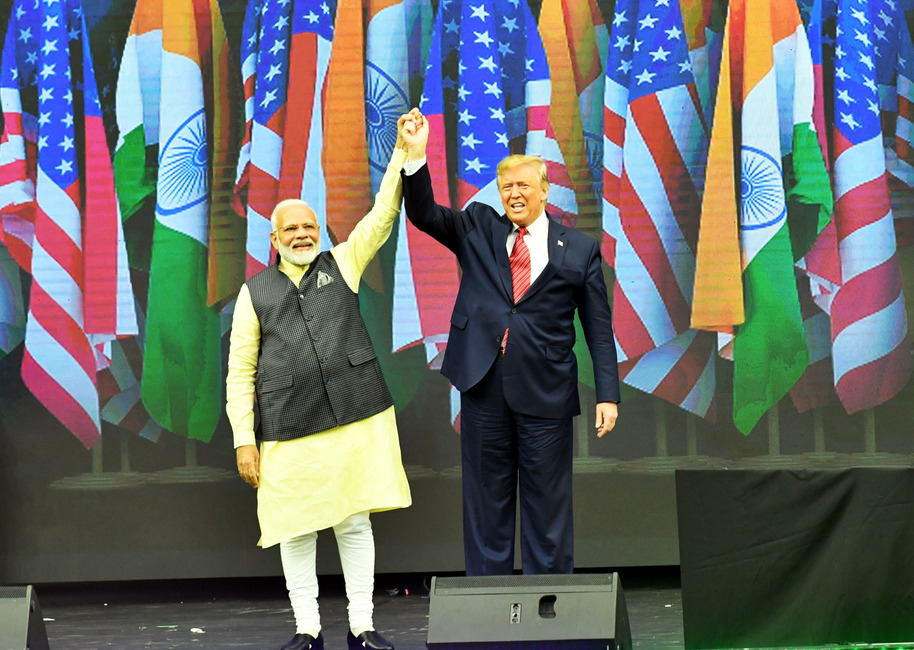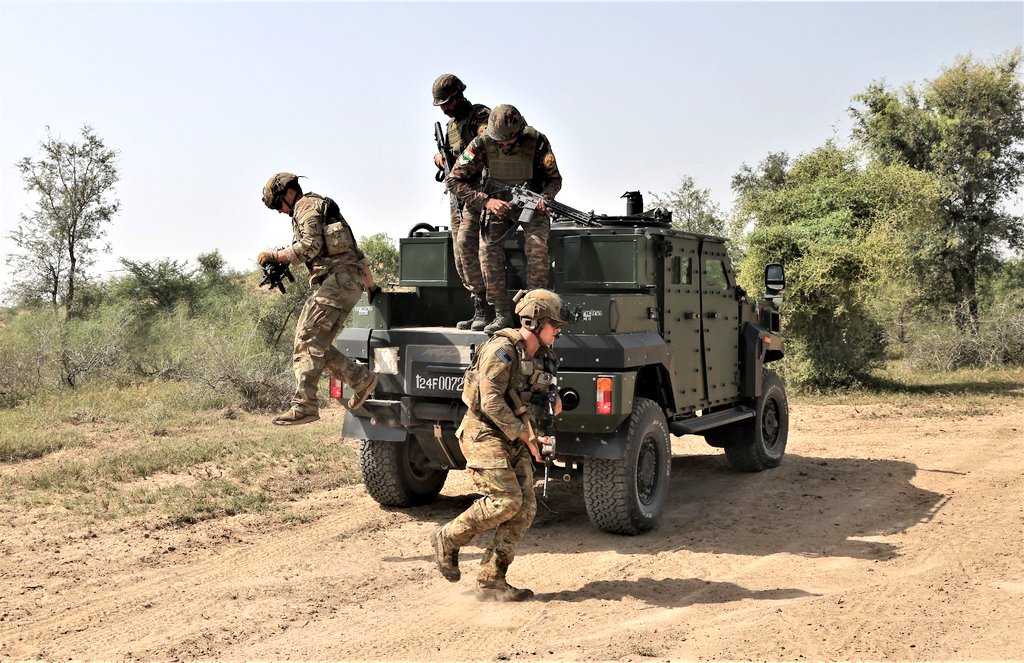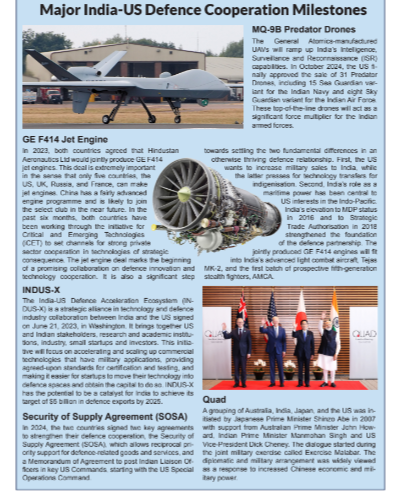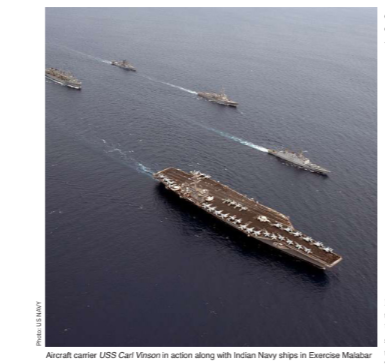
Synergies in areas of geo-strategic interest between India and the US will lead to further deepening of the partnership between the two countries under the Modi-Trump watch
“To have the world’s largest democracies with some of the most innovative workers and companies working more closely together on strategic technologies and how we can leverage them for security is a natural next step in the Indo-US relationship,” said a Defence Department official at a briefing of reporters at the Pentagon in June 2023. India and the US—the two largest democracies in the
world—have maintained relations since the former’s independence in 1947, which has evolved into a strategic partnership. It was the personal equation between Prime Minister Narendra Modi and President-elect
Donald Trump during the latter’sterm that
marked a real turn in the deepening of
this relationship.
Given the growing tensions in Asia, an expansionist China, the turbulence
in the world economy and his previous
equations with Modi, Trump’s policies are
most likely to be India-friendly. When it
comes to strategic alliances, Trump is likely to be vocal about strengthening ties with India as in his first term. During Trump’s previous term, the Indo-US strategic relationship achieved important milestones wherein foundational defence agreements like the Basic Exchange and Cooperation Agreement (BECA), Communications
Compatibility and Security Agreement
(COMCASA) and Logistics Exchange and
Memorandum of Agreement (LEMOA)
were signed. The mutual agreement on a
“free and open Indo-Pacific” region could facilitate much stronger defence coopera-
tion in the coming days under the Trump- Modi watch.
In the early years after 1947, the US developed close relations with Pakistan,
which meant India cultivated strategic and military relations with the Soviet Union. In 1961, India became a founding member of the Non-Aligned Movement (NAM) to abstain from aligning with either the US or the Soviet Union in the Cold War between
the two superpowers. India-US relations
touched rock bottom in the 1970s after the Nixon administration’s overt support for Pakistan during the Indo-Pakistan war of 1971. This scenario started changing during the ’90s, post the withdrawal of Soviet forces from Afghanistan followed by the breakup of the Soviet Union and the emergence of China as a military and economic superpower. The new geo-strategic alignment resulted in India’s altered preference for importing US military hardware. The steady improvement in India-US relations
started during the NDA I and II regimes led by Atal Bihari Vajpayee, after an initial hiccup due to India’s nuclear testing in 1998, and followed the same trajectory during the UPA I and II governments under Manmohan Singh. Modi gave fresh impetus to this important strategic partnership after coming to power in 2014.
In the 21st century, New Delhi’s foreign policy has sought to leverage India’s strategic autonomy to safeguard sovereign rights and promote national interests within a multipolar world. Since 2014, strategic cooperation between the two nations has expanded tremendously. India was declared a Major Defence Partner (MDP) of the US. India and the US have also stepped
up their cooperation in multilateral groups such as the QUAD and I2U2 groups. Former US President George W. Bush once commented, “India is a great example of
democracy.” In November 2010, President Barack Obama, while addressing the Indian Parliament on a state visit, backed India’s bid for a permanent seat on the United Nations Security Council.
Active US-India military cooperation-
Given the growing tensions in Asia, an expansionist China, the turbulence in the world economy and his previous equations with Modi, Trump’s policies are most likely to be India- friendly. When it comes to strategic alliances, Trump is likely to be vocal about strengthening ties with India as in his first term.
nomic liberalisation of India when US Lt Gen. Claude M. Kicklighter, commander of the United States Army Western Command (later United States Army Pacific), proposed army-to-army cooperation. In 2001, India offered the US military facilities within its territory for offensive operations in Afghanistan. In 2005, US Defence Secretary Donald Rumsfeld and his Indian counterpart, Pranab Mukherjee, signed a “new framework for India-US defence”.
In March 2009, the Obama administration cleared the $2 billion sale of eight P-8 Poseidons, followed by a $5 billion agreement for the sale of C-17 military transport aircraft and General Electric F414 engines.
This made the US one of the top three military suppliers after Israel and Russia. Mike Mullen, who served as the chairman of the US Joint Chiefs of Staff from 2007-11, encouraged stronger military ties between the two nations. “India has emerged as an increasingly important strategic partner of the US,” said Mullen during his tenure.
The US Undersecretary of State, William
J. Burns, reiterated, “Never has there been a moment when India and America mattered more to each other.”
As a precursor to the deepening of India-US defence cooperation there was a

Inter-operability between Indian and US armed forces has come of age through exercises like Yudh Abhyas in the past two decades


series of confidence-building initiatives over the past few years. The rapid growth of India’s economy led to closer ties between Indian and US industry, especially in information and communications technology, the engineering and medical sectors, and robust cooperation on counter-terrorism, easing of export controls over dual-use goods and technologies, and acceptance of India’s strategic programme—which constitute important milestones in strengthening the strategic relationship between the two countries.
In October 2018, India inked a historic agreement worth $5.43 billion with Russia to procure the S-400 Triumf surface-to-air missile defence system, ignoring the US’ Countering America’s Adversaries Through Sanctions Act (CAATSA).
The US threatened India with sanctions,
which was strongly opposed by Mukesh Aghi, the president of the US-India Strategic Partnership Forum (USISPF). The Trump administration finally avoided
sanctioning India for buying the Russian S-400 system.
Foundational Agreements
The US has four foundational agreements with its defence partners, including India. The first of the four agreements is the General Security Of Military Information Agreement (GSOMIA), which was inked in 2002. The agreement enables the sharing of military intelligence between the two countries and requires each country to protect the other’s classified information. The second agreement, LEMOA, was signed by the two countries on August 29, 2016. It permits the military of either country to use each other’s bases for resupplying or carrying out repairs. The agreement doesn’t make the provision of logistic support binding on either country.
The third agreement, COMCASA, was signed during the inaugural 2+2 dialogue
in September 2018. It’s an India-specific variant of the Communications and Information
Security Memorandum of Agreement (CISMOA) that enables the two countries to share secure communication and exchange information on approved equipment during bilateral and multinational training exercises and operations.
The fourth agreement, BECA, signed in 2020, permits the exchange of unclassified and controlled unclassified geospatial products, topographical, nautical and aeronautical data, products and services between India and the US National Geo spatial Intelligence Agency.
The US and India should build on the outcomes of all the recent military developments to negotiate a Security of Supply Arrangement and Reciprocal Defence
Defence trade between India and the US shot from $1 billion in 2008 to over $20 billion in 2023.
This highlights India’s gradual shift from Russian dependency to diversifying its defence portfolio with US militaryware which will depend on the US emerging as a reliable defence cooperation partner
Procurement. The former will allow India to request priority delivery of orders from US firms, while the latter will promote synergy in research, development and interoperability between the two countries.
These agreements will facilitate working
together during unanticipated disruptions
and possibly open channels for wartime
cooperation. Defence trade between India
and the US shot from $1 billion in 2008
to over $20 billion in 2023. This highlights India’s gradual shift from Russian dependency to diversifying its defence portfolio with US militaryware which will depend on the US emerging as a reliable defence cooperation partner and with Trump around, it appears certain.




Add Comment